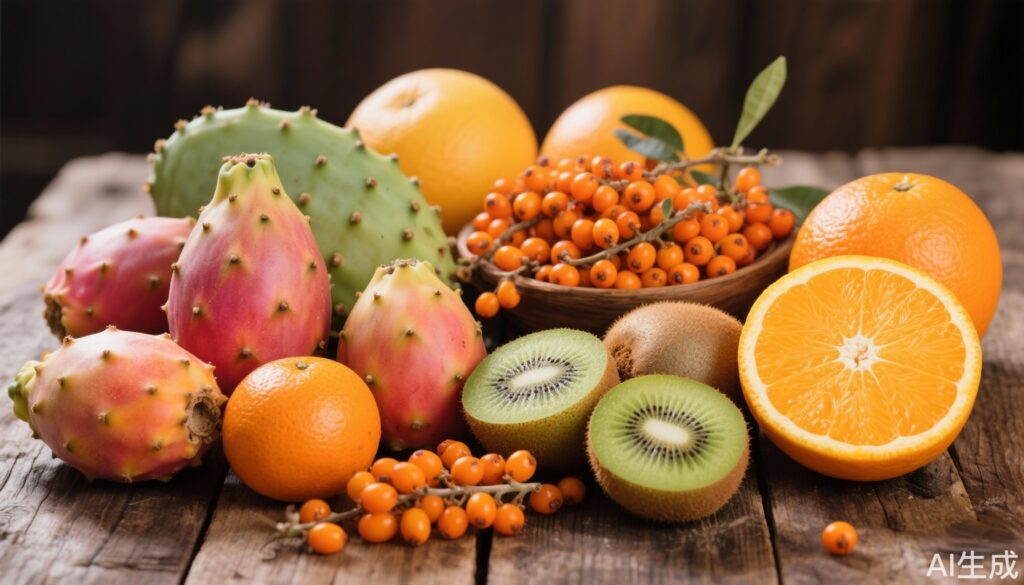Introduction
Vitamin C is one of the most celebrated nutrients for supporting immune health, antioxidant defense, and overall well-being. While many people know fruits as excellent sources of vitamin C, few realize which fruits contain the highest levels and how to maximize their benefits. This article explores the “Vitamin C titans” among fruits—those surprising fruits with exceptionally high vitamin C content and health-promoting properties—and offers practical advice on incorporating them effectively into your diet.
Scientific Evidence: The Vitamin C Powerhouses in Fruits
Vitamin C, or ascorbic acid, is an essential water-soluble vitamin that humans cannot synthesize internally and must obtain from dietary sources. It plays critical roles in collagen production, antioxidant activity, iron absorption, wound healing, and immune system support. Let’s examine some fruits notable for their remarkable vitamin C content and related health benefits.
Prickly Pear Fruit (刺梨) – The Vitamin C King
Prickly pear fruit, also known as Ci Li, Shan Wang Guo, or Song Chun Gui, is hailed as the “Vitamin C King” with a staggering 2,585 mg of vitamin C per 100 grams—approximately 50 times more than oranges and 40 times more than kiwi. Besides vitamin C, it contains 2,900 micrograms of carotenoids per 100 grams, which help protect vision, enhance immunity, and offer antioxidant and potential anti-tumor effects. Prickly pear also contains tannins, flavonoids, organic acids, and dietary fiber that aid digestion and alleviate gastrointestinal discomfort.
*Tip:* Remove the spines and seeds before consumption. The fruit’s crisp texture and sweet-and-sour taste can be quite acidic, so it may be challenging for new eaters or those with excessive stomach acid.
Winter Jujube (冬枣)
Winter jujube, known by names like Lu Bei Dong Zao and Ice Sugar Jujube, boasts 243 mg of vitamin C per 100 grams—over 60 to 70 times the vitamin C content of apples and 4 to 5 times that of kiwi. It’s rich in dietary fiber, potassium, vitamins A and E, making it a versatile fruit for boosting immunity and supplementing nutrition. Eating 5 to 8 pieces daily offers a substantial vitamin C boost.
*Tip:* Winter jujube is high in sugar (27.8 g/100 g); individuals with blood sugar concerns should moderate intake.
Sea Buckthorn (沙棘)
Sea buckthorn berries are small, round, and bright orange to red. They provide 204 mg of vitamin C per 100 grams, 4 to 5 times more than kiwi. The berries are abundant in vitamin E, K, B vitamins, carotenoids (3,840 micrograms/100 g), flavonoids, and unsaturated fatty acids. Their bioactive compounds confer digestive benefits, cough relief, improved circulation, and immune enhancement.
*Tip:* While beneficial, sea buckthorn is a health food and should not be used as a substitute for medical treatment.
Kiwi (猕猴桃)
Kiwi, a berry with green, yellow, or red flesh varieties, contains 62 mg of vitamin C per 100 grams. It is packed with natural antioxidants and lutein, which combat free radicals and slow aging. Kiwi also offers chromium, aiding glucose tolerance and blood sugar control. Freshly picked kiwi is usually firm; storing it with ethylene-releasing fruits like apples or bananas speeds softening.
*Tip:* People with weak digestive systems or diarrhea should limit consumption to avoid aggravating symptoms.
Hawthorn (山楂)
Hawthorn fruit, deep red and round, is native to China and popular in snacks like candied hawthorn. It contains 53 mg of vitamin C per 100 grams, 2 to 3 times that of oranges. It’s rich in minerals such as calcium, potassium, and iron, with enhanced iron absorption due to its vitamin C and organic acid content. Hawthorn helps alleviate indigestion and promote healthy digestion.
*Tip:* Avoid if you have excess stomach acid or if you are pregnant.
Grapefruit (葡萄柚)
A natural hybrid of sweet orange and pomelo, grapefruit has a vitamin C content of 38 mg per 100 grams, surpassing apples considerably. It contains abundant potassium beneficial in blood pressure regulation. However, grapefruit interacts dangerously with certain blood pressure and cholesterol medications, potentially causing elevated drug levels.
*Tip:* Individuals with cold constitutions should avoid grapefruit due to possible diarrhea and dizziness.
Kumquat (金橘)
Kumquat (golden orange) is a small round fruit with sweet peel and sour pulp. It contains 35 mg of vitamin C per 100 grams and bioactive compounds like kumquatin and flavonoids. The fruit has cough-relieving and anti-inflammatory properties.
*Tip:* Avoid eating on an empty stomach to prevent gastric irritation; high sugar content warrants moderation for diabetics.
Orange (橙子)
The familiar hybrid of pomelo and mandarin, oranges offer around 33 mg of vitamin C per 100 grams. Rich in flavonoids, limonene, beta-carotene, pectin, potassium, calcium, and magnesium, oranges help bolster immunity, clear free radicals, reduce cancer risks, support cardiovascular health, improve digestion, and promote bone health.
*Tip:* People prone to allergies, with weak digestion, or diabetes should consume orange with caution.
Why Do We Need Vitamin C?
Vitamin C (ascorbic acid) is indispensable for human health. Because humans cannot synthesize it, all vitamin C must come from diet. Historically, sailors suffered deadly scurvy due to vitamin C deficiency, highlighting its vital role.
Modern science confirms vitamin C’s strong antioxidant properties, promoting collagen synthesis, wound repair, cardiovascular maintenance, iron absorption, aging delay, inflammation mitigation, and immune enhancement.
Unlike many water-soluble vitamins, some vitamin C can be stored temporarily in the body; however, prolonged insufficient intake can lead to deficiency signs such as fatigue, reduced appetite, swollen gums, point-like skin hemorrhages, and bleeding gums, especially at the gum edge.
The recommended daily intake for adults is about 100 mg, but doses around 200 mg daily may better prevent chronic diseases. The Chinese Dietary Guidelines (2022) suggest consuming 200–350 grams of fresh fruits daily, preferably those high in vitamin C.
Common Pitfalls and Misconceptions in Fruit Consumption
Despite fruits being “natural vitamin supplements,” improper consumption can diminish nutritional benefits or cause health issues.
Freshly Squeezed Juice Is Not a Replacement for Whole Fruits
Vitamin C is sensitive to oxygen and light and degrades quickly during juicing. Thus, the vitamin content in fruit juice can be much lower than whole fruit. Also, juicing removes important dietary fiber that aids digestion.
Freshness Matters
Fruits lose nutrients over time due to dehydration and oxidation. Older, shriveled fruits not only taste worse but have reduced antioxidant and vitamin contents.
Watching Sugar Intake
Individuals with prediabetes or diabetes should limit fruit intake to 50–150 grams daily to avoid excess caloric and sugar intake, adjusting other carbohydrate sources accordingly.
Eating Timing
Eating fruits between meals or after exercise helps maintain stable blood sugar and supplies needed nutrients without overtaxing the digestive system. Frequent smaller servings (2–3 times/day, ~50 g each) are preferable over large single servings.
Expert Insights and Practical Tips
Nutrition experts emphasize the importance of dietary variety, recommending a rainbow of fruits to harness diverse nutrients. High-vitamin C fruits like prickly pear and sea buckthorn offer unique benefits but may be unfamiliar in many diets.
Incorporating these fruits carefully, respecting individual tolerance, existing medical conditions, and medication interactions, is key. For example, grapefruit should be avoided if taking certain drugs, and high-sugar fruits should be limited in diabetes.
Patient Scenario: Sarah’s Journey to Boost Immunity Naturally
Sarah, a 35-year-old teacher, noticed frequent colds and fatigue during winter. Curious about natural ways to enhance her immunity, she consulted a nutritionist. The expert recommended daily inclusion of vitamin C-rich fruits like kiwifruit and winter jujube while introducing prickly pear in small amounts due to its high acidity.
Over weeks, Sarah experienced fewer colds and better energy. She learned to eat fresh fruits rather than juices and to space fruit intake between meals to optimize digestion and blood sugar control.
Conclusion
Vitamin C is a cornerstone nutrient for health, and fruit consumption is a flavorful, natural way to meet daily requirements. The often-overlooked vitamin C “ceiling” fruit is prickly pear, far surpassing popular fruits like oranges and kiwi in vitamin C content.
Choosing a range of fruits including winter jujube, sea buckthorn, kumquat, hawthorn, grapefruit, and oranges can provide diverse nutrients and additional health benefits. However, consuming fruits correctly—fresh, in moderation, and mindful of individual health conditions—is crucial to maximizing benefits and avoiding pitfalls.
By understanding the nutritional profiles and appropriate consumption practices, both the general public and health professionals can support better health outcomes through informed fruit choices.
References
1. Carr AC, Maggini S. Vitamin C and Immune Function. Nutrients. 2017;9(11):1211. doi:10.3390/nu9111211
2. Chinese Nutrition Society. Chinese Dietary Guidelines 2022.
3. Padayatty SJ, Levine M. Vitamin C: the known and the unknown and Goldilocks. Oral Dis. 2016;22(6):463-493.
4. Hemilä H. Vitamin C and Infections. Nutrients. 2017;9(4):339. doi:10.3390/nu9040339
5. U.S. Department of Agriculture FoodData Central. https://fdc.nal.usda.gov/



